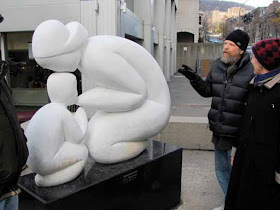When drawing or painting birds, it’s easy to get preoccupied with the feathers. But the skeletal structure beneath the feathers is equally amazing, and not as commonly studied. (Below: Jackass Penguin.)

Artist Katrina van Grouw has written and illustrated a new book called The Unfeathered Bird
Formerly the curator of ornithology for London's Natural History Museum, van Grouw produced the drawings based on actual mounted specimens. She also wrote the fascinating and readable text, which explains the function behind the structure. The book has 385 of her pencil drawings, all in natural life postures, illustrating all the major groupings of birds, from hummingbirds to penguins to songbirds to ostriches. There are both skeletal and muscular studies.

(Above: Orange-winged Parrot) The text avoids needless technical jargon, which makes it accessible to a wide range of people. Among the readers of this blog, I would recommend it to bird painters, creature designers, dinosaur artists, science illustrators, and anyone with an interest in birds.

(Above, Great Hornbill.) Van Grouw explains interesting facts about birds on every page, such as:
• Toucans aren’t strong fliers, and often collapse from exhaustion if they have to fly across a wide river.
• On most birds, the femurs are oriented horizontally in their perching or walking position, pointing forward in order to establish the legs closer to the center of gravity.
• On songbirds, the neck has a strong S-curve inside the form which allows the head to extend or retract without disturbing the airfoil shape of the outer form.
• The extensions on the back of the tongue of a woodpecker fit into a furrow that wraps all the way around the back skull.
The hardback book is 10 by 12 inches, published by Princeton University Press
Amazon: The Unfeathered Bird by Katrina van Grouw
More about the making of the drawings
Interview on the Smithsonian blog
The book's Facebook page
More about the making of the drawings
Interview on the Smithsonian blog
The book's Facebook page




























